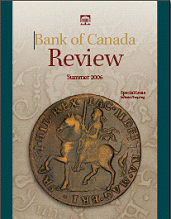Summer 2006

|
Credibility with Flexibility: The Evolution of Inflation-Targeting Regimes, 1990–2006 by Graydon Paulin
Evaluating Measures of Core Inflation
Another Look at the Inflation-Target Horizon
See also: Tables A1, A2, and Notes to the Tables Full Review (PDF, 761 kb) |
Cover: Irish Gun Money
David Bergeron, Curator
Throughout history, issuing authorities have found ingenious and practical methods of supplying currency in times of emergency. In New France, money printed on playing cards was temporarily used to pay soldiers. During the BoerWar in South Africa, Lord Baden-Powell issued notes to furnish the inhabitants of the besieged town of Mafeking with currency. In Ireland, James II resorted to melting down old cannons to make coins.
James, who had been deposed from the English throne in the Glorious Revolution of 1688, landed in Ireland in 1689. In need of currency to pay the 5,000 French troops he had brought with him in an attempt to regain his throne, he first tried to raise the value of British and French coinage to encourage their circulation in the area. When that scheme failed, he resorted to the production of "gun money": coins made of brass and copper from old cannons and other sources were struck in denominations of sixpence, shillings, half-crowns, and crowns. At that time, coins of these denominations were typically struck in sterling silver.
To ensure the acceptance of the emergency coinage, James issued a proclamation at Dublin on 18 June 1689, that all copper and brass money be "made current for the present necessity." The public were reassured that the brass coins would eventually be exchanged for their equivalent in gold and silver. Gun money was issued for just over a year, from July 1689 to October 1690. The short duration was not, however, a consequence of James's promise.
Equipment and tools had been seized to convert the old cannons into coins. As more were produced, brass became scarce, and its value increased. To remedy the problem, half-crowns and shillings were reduced in size, and coins struck before May 1690 were recalled and replaced with others of almost half the weight and one-quarter the size.
Pictured on the cover are a crown and half-crown. The obverse of the crown depicts James on horseback as he appeared riding into Dublin. On the reverse is the coat of arms of England, Scotland, France, and Ireland. The half-crown bears the portrait of the king and the legend IACOBVS II DEI GRATIA (James II by the Grace of God) on the obverse, while the reverse (shown in the background) bears the king's crown, his monogram, and the value (in pence). In an unusual departure, the month in which the coin was minted was included on the smaller denominations to confirm the currency value of the coins until a new proclamation was issued.
To the public's dismay, gun money failed because James II was soon overthrown whenWilliam III invaded Ireland. William subsequently ordered that all gun money be redeemed at a fraction of its face value: crowns and large half-crowns for one penny, smaller half-crowns for three farthings, shillings for a halfpenny, and so on. On 23 February 1692, gun money was totally abolished, bringing this unhappy episode to an end.
The coins pictured on the cover are part of the National Currency Collection of the Bank of Canada.
Photography by Gord Carter




